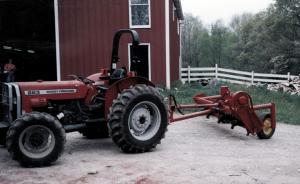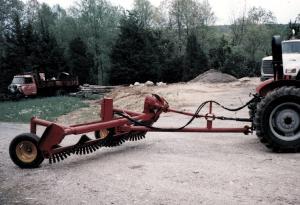2000 - Volume #24, Issue #5, Page #26
[ Sample Stories From This Issue | List of All Stories In This Issue | Print this story
| Read this issue]
Rock Rake Made From Old Pipe And Baler Parts
 |
 |
When he looked at the remains of the baler and a pile of old pipe he'd purchased from a friend, he got the idea for a rock rake.
Geer started with a 10-ft. length of 4-in. pipe. "Most of the pipe was lighter, but this had a 3/8-in. wall heavy enough so I could weld teeth on to make the rake," he explains.
The teeth for his auger-shaped rake are cut from 2 by 3/4-in. bar stock, cut 6 in. long. He spaced these around the 4 in. pipe so they would pick up and windrow most rocks from the smallest to those that are 10 to 12 in. in size. "If they're bigger than that, we pick them up with a stone fork on a front end loader," he says.
He made caps for the end of the pipe and welded those in place. The ends run in spherical roller bearings that he salvaged from the garbage dump. "I found several of them there one day, brand new still in boxes. The guy who managed the place said they should be used for something, so I took them home," he says.
On the drive side, he welded a short shaft and put a sprocket on it.
To power the rock rake, he used the gearbox from the Super 66 baler. "I had to turn the shaft down so I could use sprockets with the same shaft size on both the gearbox and the rake."
The gearbox turns the auger with a no. 100 roller chain. A chain tightener helps keep it at the right tension. The entire drive is safety shielded.
The wheels, tires and spindles are from the Super 66 baler. He made the axles, frame, lift and tongue from the 4-in. fire pipe.
While he wanted to power the rake with the tractor's pto, he didn't want the hassle of a long pto shaft. So he mounted a short shaft about 3 ft. from the front of the tongue. One end already had no. 6 splines, so he machined splines into the other end. This way, he was able to borrow shorter pto drive shafts from a couple of other implements to drive the rock rake.
A hydraulic cylinder with an 8-in. stroke and 4-in. bore lifts the rake. "It doesn't take a lot of hydraulic capacity to raise it," he says. "And it doesn't take much horsepower to run it, either.
We've used it behind our Massey Ferguson 263 and also with our old Ford Super Dexta. The Super Dexta has about 30 hp."
The rake auger itself turns at about 200 rpm's. Geer says if you run in low gear, it not only windrows the rocks, but also leaves the field surface looking like it's been hand raked.
"I built it last year. It's been used on a couple of our smaller fields. We windrow the rocks and then pick them up with a rock picker. It goes faster that way. In smaller fields, we can windrow from the center to the edges, moving the rocks and windrowing toward the edge with each pass."
Geer says nearly everything he used to build it was from old parts he had around the farm. "I had to buy the two drive sprockets, the chain, hydraulic hose and the lift cylinder," he says. "Total cost was $700."
Contact: FARM SHOW Followup, Robert Geer, Jr., 63 Thomas Road, Ledyard, Connecticut 06339 (ph 860 464-1167; fax 860 464-0167).

Click here to download page story appeared in.

Click here to read entire issue
To read the rest of this story, download this issue below or click here to register with your account number.




